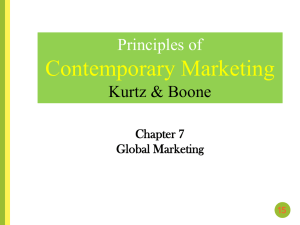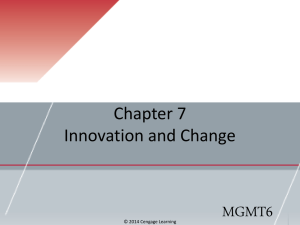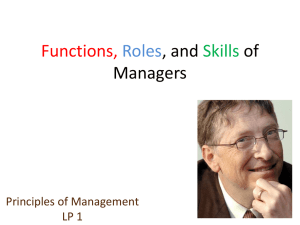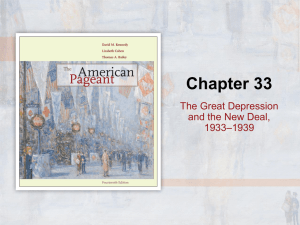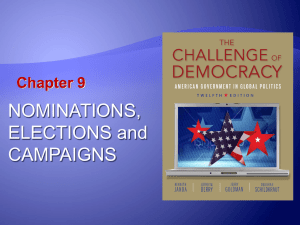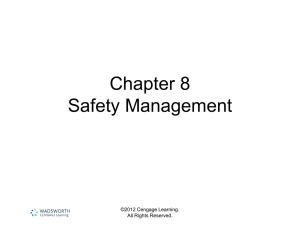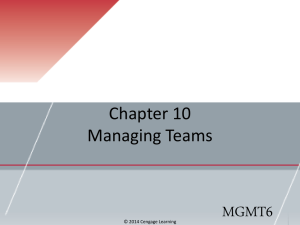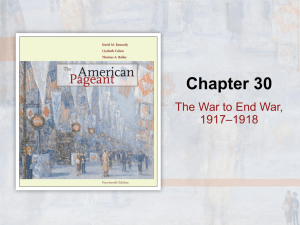Strategies for Creating Success in College and in Life
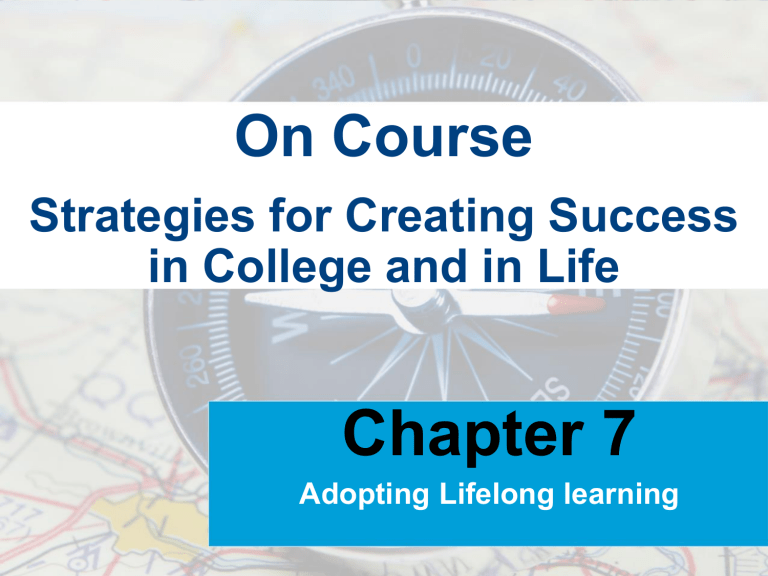
On Course
Strategies for Creating Success in College and in Life
Chapter 7
Adopting Lifelong learning
CHOICES OF SUCCESSFUL STUDENTS
ADOPTING LIFELONG LEARNING
Copyright © Cengage Learning. All rights reserved.
7 | 2
REVIEW: THREE SUCCESS RULES
Rule 1: I Show Up
Rule 2: I Do My Best Work
Rule 3: I Participate Actively
Copyright © Cengage Learning. All rights reserved.
7 | 3
REVIEW: SCRIPTS
What three habit patterns form the parts of our scripts that are observable to others?
Behaviors
Thoughts (when spoken)
Emotions (when strong)
What is the deeper, invisible part of a script that contains our view of ourselves, other people and the world?
Core Beliefs
Copyright © Cengage Learning. All rights reserved.
7 | 4
Copyright © Cengage Learning. All rights reserved.
7 | 5
REVIEW: INNER VOICES
Identify which voice is speaking in each of the following examples:
Inner Critic
Inner Defender
Inner Guide
Copyright © Cengage Learning. All rights reserved.
7 | 6
REVIEW : INNER VOICES
I flunked that test, big time! Malik and Jordan were making so much noise I couldn't concentrate last night when I was studying.
I'm really struggling with this lit class. I'm just too dumb to figure out all that stuff.
Teresa is so smart! I'm going to ask her to join our study group for Calculus.
I would have been here on time but Deven took my parking space. What a jerk!
I've got to come up with $1000 for next semester. I'm going to check the papers for job ads and re-do my budget.
I would love to learn how to snow ski but I'm so spastic I'll probably run over somebody and kill both of us.
Copyright © Cengage Learning. All rights reserved.
7 | 7
REVIEW : INNER VOICES
What do the
Inner Critic and Inner Defender have in common?
They both use Victim Language to complain , blame , and make excuses !
Neither takes action to solve the problem.
Copyright © Cengage Learning. All rights reserved.
7 | 8
REVIEW: HOLLAND CODE
What are the six personality types in the Holland
Code?
Realistic
Investigative
Artistic
Social
Enterprising
Conventional
How can awareness of your personality type help you make better career choices?
People who choose a career that matches their personality type tend to be more satisfied.
Copyright © Cengage Learning. All rights reserved.
7 | 9
CASE STUDY IN CRITICAL THINKING:
A FISH STORY
Why do you think the biology professor didn’t simply tell the students what he wanted them to learn?
DIVING DEEPER: If you had been in this biology lab class, what lessons about college and life would you have learned from the experience? When you think you have discovered one life lesson, dive deeper and find another even more powerful lesson. And then another and another.
Copyright © Cengage Learning. All rights reserved.
7 | 10
DISCOVERING YOUR
PREFERRED LEARNING STYLE
FOCUS QUESTIONS
What is your preferred way of learning?
What can you do when your instructor doesn
’ t teach the way you prefer to learn?
Copyright © Cengage Learning. All rights reserved.
7 | 11
JOURNAL ENTRY 24: WARM-UP
Complete the Preferred Learning Style
Inventory.
Rank each option honestly, realizing there are no wrong answers.
Calculate your score following the directions in the book.
What is the biggest surprise in your results?
Copyright © Cengage Learning. All rights reserved.
7 | 12
APPLYING THE CONCEPT
Identify which of the four learning preferences is being described.
Enjoys discovering and using intuition; prefers imagination to data and facts.
Enjoys taking action and appreciates well-organized and well-documented information.
Enjoys using analysis and logic; prefers facts and theories over emotion and intuition.
Enjoys personal connections and supportive atmosphere.
Innovating
Learner
Doing
Learner
Thinking
Learner
Feeling
Learner
Copyright © Cengage Learning. All rights reserved.
7 | 13
APPLYING THE CONCEPT
Which of the preferred learning preferences would be most comfortable with the instructors described below?
Warm and caring; uses group work and interpersonal relating.
Presents information step-by-step; uses demonstration and hands-on experience.
Uses lectures, visual aids, textbook readings and logical thinking activities.
Encourages creativity and experimentation; is flexible and allows independent work.
Feeling
Learner
Doing
Learner
Thinking
Learner
Innovating
Learner
Copyright © Cengage Learning. All rights reserved.
7 | 14
APPLYING THE CONCEPT
Identify which learning preference would benefit most from the following ways of adapting to different instructors.
Seek answers to “what?” questions and organize notes logically with outlines.
Seek answers to “what if?” and “what else?” questions and organize notes with concept maps and pictures.
Seek answers to “how?” questions and practice using course information outside of class.
Seek answers to “who?” and “why?” questions and discover personal value for the course content.
Copyright © Cengage Learning. All rights reserved.
Thinking
Learner
Innovating
Learner
Doing
Learner
Feeling
Learner
7 | 15
ONE STUDENT'S STORY:
Melissa Thompson
What choices did Melissa make to move from a struggling student to a successful student in chemistry?
What present instructor of yours has a teaching style that you find difficult to learn from? Explain.
Considering Melissa's story, what choices could you make to improve your outcomes and experiences in that instructor's class?
Copyright © Cengage Learning. All rights reserved.
7 | 16
EMPLOYING CRITICAL THINKING
FOCUS QUESTIONS
How can you determine the truth in this complex and confusing world?
How can you present your truths in a way that is logical and persuasive to others?
Copyright © Cengage Learning. All rights reserved.
7 | 17
CONSTRUCTING LOGICAL ARGUMENTS
Reasons
•Premises, Claims, Assumptions
•Answers "Why?"
Evidence
•Support: Facts, Data, Stories
•Answers "How do you know?“
Conclusions
•Opinions, Beliefs, Positions
•Answers "What should the audience think or do?"
Copyright © Cengage Learning. All rights reserved.
7 | 18
APPLYING THE CONCEPT:
PROBING QUESTIONS
Imagine that a friend presents you with the argument below. As a critical thinker, what probing questions might you ask about his reason, evidence, and conclusion?
[Reason]
I’ve decided that I’m not really college material.
[Evidence]
I’m taking four courses and it looks like I’m going to get only one B and 3 D’s.
[Conclusion]
I think I’ll drop out before I flunk out.
Copyright © Cengage Learning. All rights reserved.
7 | 19
QUICK REVIEW!
•
•
What are the three components of a logical argument?
BECOMING AN
• Reasons
ACTIVE LEARNER
Evidence
Conclusions
Create a memory device that will help you remember the three components.
Share it with a partner.
Copyright © Cengage Learning. All rights reserved.
7 | 20
JOURNAL ENTRY 25: WARM-UP
A classmate tells you she knows a guaranteed way to make a lot of money and begins persuading you to join her in the venture.
List five or more probing questions you could ask your classmate to decide if it is a good choice for you to join her in the venture.
Copyright © Cengage Learning. All rights reserved.
7 | 21
LEARNING TO
MAKE COURSE CORRECTIONS
FOCUS QUESTIONS
How can you recognize when you are off course?
More important, how can you get back on course?
Copyright © Cengage Learning. All rights reserved.
7 | 22
JOURNAL ENTRY 26: WARM-UP
There's an old fable about a fox that can't reach some grapes that are too high on a vine. After several unsuccessful attempts, the fox gives up, excusing its failure by thinking "Those grapes are probably sour anyway.
“
Is there a class in which you've given up on reaching the "high grapes"? If so, how have you explained this choice to yourself? Is your explanation a reason or an excuse ?
Copyright © Cengage Learning. All rights reserved.
7 | 23
ONE STUDENT'S STORY:
Jessie Maggard
Sometimes, when we are off course, something happens that shakes us up and we realize we need to make an important change. What events shook up Jessie and what changes did she make as a result?
When in your life did something shake you up and you realized that you needed to make a change? Explain what happened to shake you up, what change you made, and the Life Lesson you learned from the experience.
Copyright © Cengage Learning. All rights reserved.
7 | 24
LIFELONG LEARNING AT WORK
You are about to see a number of pictures showing people at work. For each picture, decide which learning preference (or preferences) would best suit the career represented.
As a critical thinker, be prepared to explain your conclusions by offering reasons and evidence .
Copyright © Cengage Learning. All rights reserved.
7 | 25
LIFELONG LEARNING AT WORK
Thinking Doing Feeling Innovating
Copyright © Cengage Learning. All rights reserved.
7 | 26
BELIEVING IN YOURSELF
:
DEVELOP SELF-RESPECT
FOCUS QUESTIONS
What is your present level of self-respect?
How can you raise your self-respect, and therefore your self-esteem, even higher?
Copyright © Cengage Learning. All rights reserved.
7 | 27
INTEGRITY
At the top of a piece of paper, write the word
"Integrity.“
In a moment, words will appear on the screen one at a time.
When you see a word that you associate with the idea of “integrity,” write it on your page.
Here we go…
Copyright © Cengage Learning. All rights reserved.
7 | 28
Reliability
Uprightness
Weak
Betrayal
Character
Consistency
Friend
INTEGRITY
Honesty
Cheating
Wholeness
Truthfulness
Honor
Hypocrisy
Lying
Completeness
Unity
Enemy
Trustworthy
Strong
Deceptive
Dependable
Copyright © Cengage Learning. All rights reserved.
7 | 29
BECOMING AN ACTIVE LEARNER
Below your list, write one of the following:
• A definition of “integrity.”
• A true story that illustrates integrity
(about yourself or someone else)
Form Groups of 3 or 4.
Each person, read to your group what you have written. After all have read, continue the conversation about integrity.
Copyright © Cengage Learning. All rights reserved.
7 | 30
KEEPING COMMITMENTS
Make agreements consciously : I
’ m going to accept
Eric
’ s invitation to join his study group because it will help me get better grades.
Use Creator language: I will attend all study group meetings and come prepared.
Make agreements important : I
’ ll send an email to each study group member with my commitment.
Create a plan; carry it out : I
’ ll put each meeting on my calendar.
Renegotiate: If I'm unable to attend a meeting, I
’ ll ask if others are willing to change the date.
Copyright © Cengage Learning. All rights reserved.
7 | 31
KEEPING COMMITMENTS
Write about the most important commitment you have made in college. Explain how keeping this commitment will help you create your desired outcomes and experiences. (5 minutes)
Get with a partner and exchange papers.
Read your partner's paper and write a thoughtful question. A
“ thoughtful
” question is one that helps your partner dive deeper into the complexities of the topic. (3 minutes)
When you receive your partner
’ s question, write a thoughtful response. (5 minutes)
Copyright © Cengage Learning. All rights reserved.
7 | 32
EMBRACING CHANGE:
DO ONE THING DIFFERENT THIS WEEK
From the list of seven beliefs and behaviors, choose the one that seems the most likely to help you achieve your desired outcomes and experiences in college.
With a partner discuss the value you would get from doing this one thing every day for a week (or longer). Also discuss any obstacles to keeping this commitment. Finally, make a choice to make this commitment or not.
Copyright © Cengage Learning. All rights reserved.
7 | 33
WISE CHOICES IN COLLEGE :
WRITING
Divide into Home Groups of four.
Each person choose to become the group's expert for one of the four components of the Writing Process:
Prewriting, Writing, Revising, Editing.
Leave your Home Group and join others who have chosen to become an expert on the same component you did.
With your Expert Group , read the introduction to “Wise
Choices in College: Writing” and discuss the component you have all chosen. Your goal is to be able to explain to your
Home Group what the component is and how it relates to the CORE Learning System.
Return to your Home Group . Each expert teach the others about your component of the Writing Process.
Copyright © Cengage Learning. All rights reserved.
7 | 34
WISE CHOICES IN COLLEGE :
WRITING
1. Form groups of 3-4 and identify a recorder.
2. Without using On Course , record possible choices to improve writing skills. Each group’s goal is to have the longest list of “unique” choices (that is, choices not on any other group’s list). (5 minutes)
3. As each recorder reads a list, other recorders cross out choices on their list mentioned by others.
4. Recorders report the “unique” choices remaining on their group’s list.
5. The group with the longest list of “unique” choices is the winner.
Copyright © Cengage Learning. All rights reserved.
7 | 35
WISE CHOICES IN COLLEGE :
WRITING
Review all of the writing strategies presented in On
Course and choose the one you think would most to improve your writing.
Join a partner and explain the strategy you have chosen and why. Use your best active listening skills to be sure you understand your partner’s choice.
Join another pair and each person explain the strategy his/her partner chose and why.
Copyright © Cengage Learning. All rights reserved.
7 | 36
REVIEW & SUMMARY
What are the four preferred ways of learning?
Thinking
Doing
Feeling
Innovating
What are the three components of a logical argument?
Reasons
Evidence
Conclusions
Copyright © Cengage Learning. All rights reserved.
7 | 37
REVIEW & SUMMARY
What are the four components of the writing process?
Prewriting
Writing
Revising
Editing
Copyright © Cengage Learning. All rights reserved.
7 | 38
KEY CHOICES FOR
ADOPTING LIFELONG LEARNING
Learning to
Make Course
Corrections
Employing
Critical
Thinking
Discovering Your
Preferred
Learning Style
Copyright © Cengage Learning. All rights reserved.
7 | 39
TICKET OUT
Who do you know who is a good example of a Lifelong Learner? Explain briefly.
Copyright © Cengage Learning. All rights reserved.
7 | 40
Copyright © Cengage Learning. All rights reserved.
End
Chapter
Seven
7 | 41
